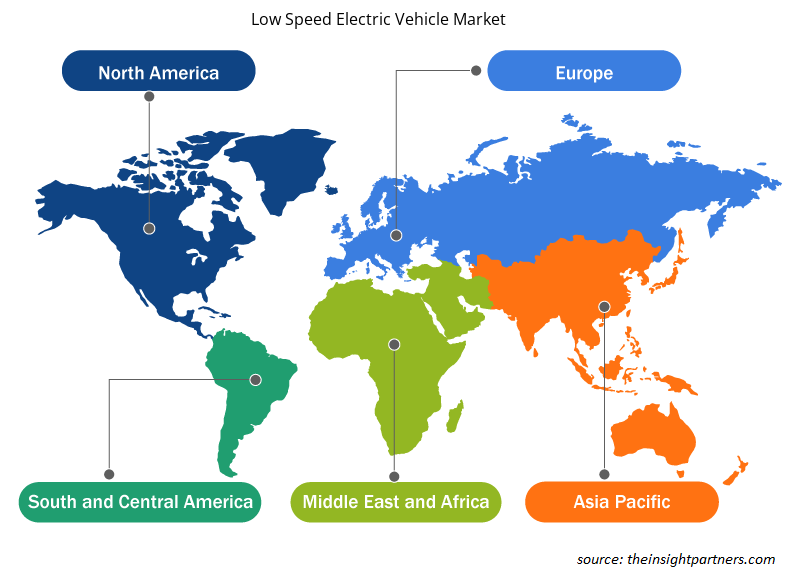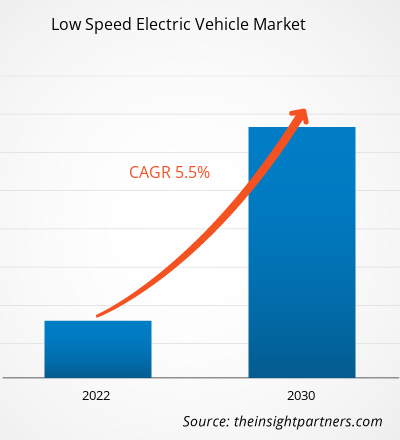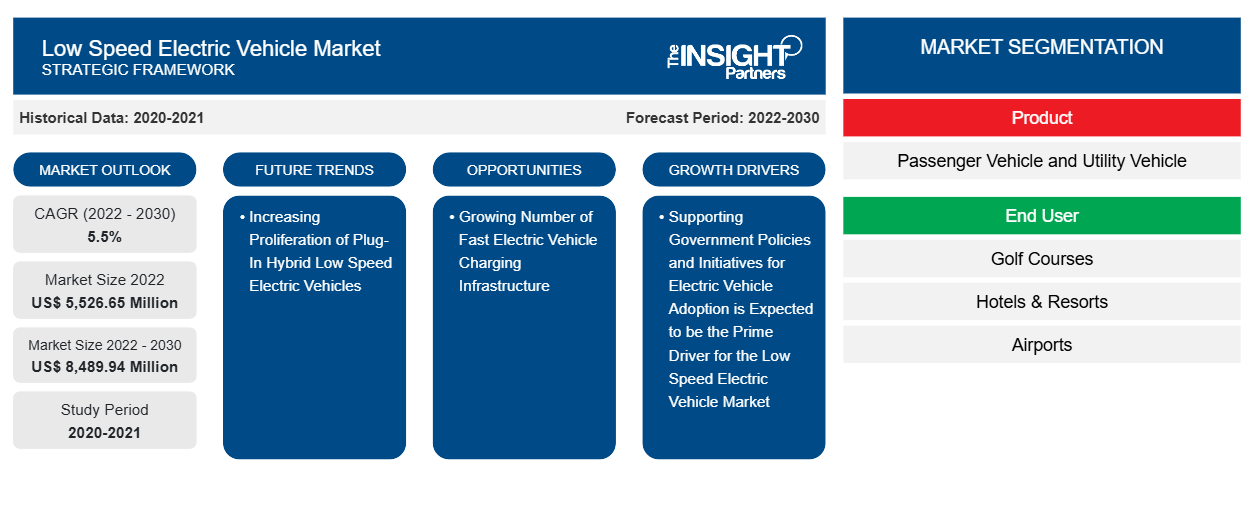2022 年低速电动汽车市场规模为 55.2665 亿美元,预计 2022 年至 2030 年的复合年增长率为 5.5%,到 2030 年将达到 84.8994 亿美元。对提高燃油效率的日益重视可能仍将是市场的一个主要趋势。
低速电动汽车市场分析
过去几年,全球低速电动汽车市场发生了显著变化,标志着环保汽车的贸易和采用大幅增加。2022 年,电动和混合动力汽车的进口动态发生了显著变化,反映出人们对可持续出行解决方案的偏好日益增加。值得注意的是,进口电动和混合动力汽车类型的重大转变正在推动全球低速电动汽车市场的发展。
低速电动汽车市场概览
随着全电动汽车销量呈上升趋势,低速电动汽车市场经历了显著的转变。随着消费者更喜欢环保替代品并放弃柴油汽车,预计在预测期内将推动低速电动汽车市场的发展。汽车行业正在实施替代解决方案,以满足各立法者制定的不断变化的排放法规。
定制此报告以满足您的需求
您可以免费定制任何报告,包括本报告的部分内容、国家级分析、Excel 数据包,以及为初创企业和大学提供优惠和折扣
- 获取此报告的关键市场趋势。这个免费样品将包括数据分析,从市场趋势到估计和预测。
低速电动汽车市场驱动因素和机遇
支持政府推动电动汽车普及的政策和举措,以利于市场
化石燃料造成的环境污染日益严重,这是政府关注的主要问题之一。为了降低环境污染程度,各国政府都在强调消费者采用更清洁、可持续和环保的替代品,方法是给予销售特别折扣、奖励、丰厚的优惠和税收优惠。中国、日本、欧盟、印度、加拿大和韩国是政府积极推动低速电动汽车普及的一些主要地区,预计这将在预测期内推动低速电动汽车市场的发展。
低速电动车价格不断上涨
电池是电动汽车的主要组成部分。由于技术进步和电池价格下降,电动汽车变得越来越实惠。价格越来越实惠以及政府为选择电动汽车提供税收减免的举措越来越多,预计将在未来几年推动低速电动汽车市场的增长。
低速电动汽车市场报告细分分析
有助于得出低速电动汽车市场分析的关键部分是产品和最终用户。
- 根据产品,低速电动汽车市场分为乘用车和多功能车。乘用车细分市场在 2022 年占据了较大的市场份额。
- 根据最终用户,低速电动汽车市场分为高尔夫球场、酒店和度假村、机场、住宅和商业场所等。高尔夫球场部分在 2022 年占据了更大的市场份额。
低速电动汽车市场份额按地区分析
低速电动汽车市场报告的地理范围主要分为五个地区:北美、亚太、欧洲、中东和非洲、南美和中美。
低速电动汽车市场报告的范围包括北美(美国、加拿大和墨西哥)、欧洲(俄罗斯、英国、法国、德国、意大利和欧洲其他地区)、亚太地区(韩国、印度、澳大利亚、日本、中国和亚太地区其他地区)、中东和非洲(沙特阿拉伯、南非、阿联酋和中东和非洲其他地区)以及南美洲和中美洲(阿根廷、巴西和南美洲和中美洲其他地区)。就收入而言,北美在 2022 年占据了低速电动汽车市场份额的主导地位。亚太地区是全球低速电动汽车市场的第二大贡献者,其次是欧洲。
低速电动汽车市场区域洞察
Insight Partners 的分析师已详细解释了预测期内影响低速电动汽车市场的区域趋势和因素。本节还讨论了北美、欧洲、亚太地区、中东和非洲以及南美和中美洲的低速电动汽车市场细分和地理位置。

- 获取低速电动汽车市场的区域具体数据
低速电动汽车市场报告范围
| 报告属性 | 细节 |
|---|---|
| 2022 年市场规模 | 55.2665 亿美元 |
| 2030 年的市场规模 | 84.8994亿美元 |
| 全球复合年增长率(2022 - 2030 年) | 5.5% |
| 史料 | 2020-2021 |
| 预测期 | 2022-2030 |
| 涵盖的领域 | 按产品
|
| 覆盖地区和国家 | 北美
|
| 市场领导者和主要公司简介 |
|
低速电动汽车市场参与者密度:了解其对业务动态的影响
低速电动车市场正在快速增长,这得益于终端用户需求的不断增长,而这些需求又源于消费者偏好的不断变化、技术进步以及对产品优势的认识不断提高等因素。随着需求的增加,企业正在扩大其产品范围,进行创新以满足消费者的需求,并利用新兴趋势,从而进一步推动市场增长。
市场参与者密度是指在特定市场或行业内运营的企业或公司的分布情况。它表明在给定市场空间中,相对于其规模或总市场价值,有多少竞争对手(市场参与者)存在。
在低速电动汽车市场运营的主要公司有:
- 德事隆公司
- 雅马哈摩托车公司
- 俱乐部汽车
- 托罗公司
- 雷诺汽车公司
- 星光电动车
免责声明:上面列出的公司没有按照任何特定顺序排列。

- 了解低速电动汽车市场顶级关键参与者概况
低速电动汽车市场新闻和最新发展
低速电动车市场通过收集一手和二手研究后的定性和定量数据进行评估,其中包括重要的公司出版物、协会数据和数据库。以下列出了低速电动车市场的一些发展情况:
- Waev Inc. 宣布将为其 GEM 电动汽车增加屋顶太阳能电池板选项。GEM 微型车也称为低速汽车或社区电动汽车,是一种轻便高效的汽车,专为短距离使用而设计,最高时速为 25 英里/小时。(来源:Waev Inc,新闻稿,2023 年 8 月)
- Arcimoto 扩展到了西海岸和东海岸的其他主要市场,在康涅狄格州、北卡罗来纳州、南卡罗来纳州和新墨西哥州开放了客户订单,并于今年春季开始交付。Arcimoto 车辆目前在加利福尼亚州、俄勒冈州、华盛顿州、夏威夷州、内华达州、亚利桑那州、新墨西哥州、佛罗里达州、纽约州、新泽西州、康涅狄格州、宾夕法尼亚州、马里兰州、弗吉尼亚州、华盛顿特区、北卡罗来纳州、南卡罗来纳州和佐治亚州有售。(来源:Arcimoto,新闻稿,2023 年 5 月)
低速电动汽车市场报告范围和交付成果
“低速电动汽车市场规模和预测(2020-2030 年)”报告对以下领域进行了详细的市场分析:
- 低速电动汽车市场规模及全球、区域和国家层面所有主要细分市场的预测
- 低速电动汽车市场趋势以及驱动因素、限制因素和关键机遇等市场动态
- 详细的 PEST 和 SWOT 分析
- 低速电动汽车市场分析涵盖主要市场趋势、全球和区域框架、主要参与者、法规和最新市场发展
- 行业格局和竞争分析,涵盖市场集中度、热点图分析、知名参与者以及低速电动汽车市场的最新发展
- 详细的公司简介
- 历史分析(2 年)、基准年、预测(7 年)及复合年增长率
- PEST和SWOT分析
- 市场规模、价值/数量 - 全球、区域、国家
- 行业和竞争格局
- Excel 数据集
近期报告
相关报告
客户评价
购买理由
- 明智的决策
- 了解市场动态
- 竞争分析
- 客户洞察
- 市场预测
- 风险规避
- 战略规划
- 投资论证
- 识别新兴市场
- 优化营销策略
- 提升运营效率
- 顺应监管趋势





















 获取免费样品 - 低速电动汽车市场
获取免费样品 - 低速电动汽车市场